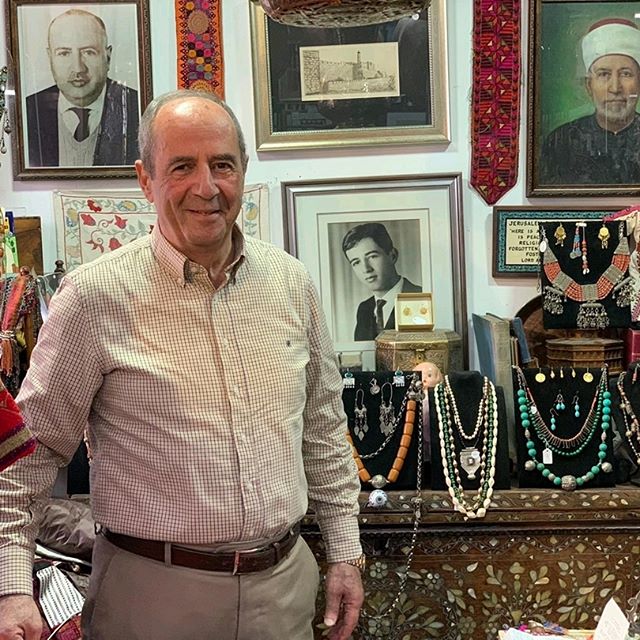Product successfully added to your shopping cart
Translation missing: en.products.wishlist.added_to_wishlist
Qty:
There are item(s) in your cart
Meet The Collector
Yasser Barakat, a native Jerusalemite, graduated from Roosevelt University in Chicago. He returned to Palestine in 1972 and taught mathematics at two of Jerusalem’s premier schools. Preparing to establish his business in his father’s shop, Yasser started collecting Palestinian dresses and a variety of artwork when he was 19 years old. Well before he opened his own gallery, Yasser amassed a beautiful collection of Palestinian dresses, cushions, hats and silver pieces. To this day, Yasser continues to search for and buy old and unique Palestinian artwork wherever he can find it. Yasser is very attached to the Old City of Jerusalem. His daily walks to and from his shop over the past thirty years now form a central part of his life. Through his shop he has formed lasting friendships with people from all around the world. Friends enjoy sitting in his gallery, sipping coffee or tea, and talking about art, politics and philosophy. The shop has become a meeting place for friends and art lovers alike from all around the world.

Each piece of Palestinian embroidery contains a story and heritage. Historically, Palestinian embroidery was typically done on either black or white linen dresses, which had triangular sleeves and whose length reached the floor. The embroidered area included a square chest piece, front and back lower panels and side panels running down from the waist. Each colour is chosen with care and with an attention to the meaning it conveys. For example, when embroidery uses green, it is meant to symbolise growth; yellow stands for harvest; brown for earth; blue against the evil eye; and black for widows. Regional Embroidery The Beit Dajan area was influenced by the Bethlehem stitches and became known for its Jallayeh dress (a dress that has an open slit from the front waist down). The Jallayeh used the half stitch, the cross stitch and the Bethlehem stitch, creating very unique designs. The Ramallah area is famous for two of its dresses. One is done on white linen and the other on black linen. Both are called Rohbanee dresses. Aside from these two, Ramallah used to have a distinct Jallayeh of indigo linen that was done in a remarkable stitch that is exactly the same when viewed from the front and the back. In coastal areas such as Jaffa, the embroidery and the dresses were somewhat different. Jaffa women would spend all their days in the fields and orchards in very hot weather. Thus, they embroidered natural patterns from their daily lives, such as cypress trees. Every woman had the chance to express her creativity with her choice of colours, patterns and fabrics, but generally each area in Palestine had its own distinct embroidery rules. Headdresses & Veils Women across Palestine accessorised their dresses with beautiful hats and headpieces (veils). Palestinian women in each area and village wore different hats. The Bethlehem hat was called Shatweh, the Hebron hat Iraqiyeh, and the one from Ramallah is known as Samdeh. Each hat contained different stitches and silver coins, depending on how wealthy the woman was. Some hats even contained gold coins to denote their wealth. Accessories & Jewelry Women’s accessories also included bracelets, necklaces, nose rings and anklets. Jewellery often had names engraved on it and contained different artwork, depending on the area it came from.
A big selection of Old Palestinian Embroidery Pieces, Origianl David Roberts Lithographs, Metal work, Handmade Carpet, Unique Jewellery, Pottery, Olive Wood, Mother Of Pearl, Paintings from well knowns Palestinian Artist and International Travellers.